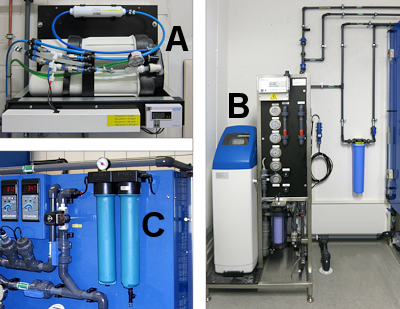Water treatment, measuring & control systems
Hauptnavigation
- HOME
- NEWS
- COMPANY PROFILE
- WORLDWIDE REFERENCES
- LARGE-SCALE SYSTEMS for Zebrafish & Xenopus
- SMALL-SCALE SYSTEMS
- REFERENCES FOR VARIOUS OTHER RESEARCH SYSTEMS
- WATER TREATMENT, MEASURING & CONTROL
- LED LIGHTING SYSTEM
- AQUA BOXES
- SPARE PARTS & ACCESSORIES
- SERVICE
- CONTACT
- IMPRINT / LEGAL NOTICE
- DATA PROTECTION
- Datenschutzhinweis
Hauptnavigation
Reverse Osmosis Units
A reverse osmosis unit produces osmosis water from ordinary tap water.
In the applications provided by us, the produced osmosis water is mostly filled in into the integrated water storage tanks of the water treatment systems.
But osmosis water can be used for other applications as well
(e. g. to fill-up osmosis water tanks in dosing units, which are used for automatically water parameter adjustment...).
Reverse osmosis units differ in the amount of osmosis water that they can produce (mainly given in "liters per hour" or "liters per day"...).
The actual production volume that is required per hour / day depends on the size of the storage tank system and the amount of water, which is required for your applications per day.
Please contact us to find the best combination of water storage tank system and reverse osmosis system for your aquarium facility.
In addition, all reverse osmosis systems require a certain minimum line inlet pressure and other tap water parameters so that osmosis water can be produced. And a certain inlet line pressure and some tap water parameters must not be exceeded. Please also ask us about these values and compare them with the conditions at your location.
Examples for reverse osmosis units:

Example A:
Small reverse osmosis unit, which has a production of approx. 80 liters per hour (actual amount depends on the incoming water pressure as well). To get a better omosis water quality, this unit has an activated carbon filter.
In most cases, this device is mounted on a console as shown at the picture. This console can be installed directly on the wall above the water storage tank or on another wall (depending on the fact, how much space is available).
This unit itself does not need a power connection as it has no electrical parts, but is only operated by an additional solenoid valve and the water pressure of the tap water pipe. Osmosis water production starts, if the solenoid valve, which is connected to the incoming tap water piping, opens (by manual switching or by an electrical timer at the switch board of the water storage tank system...).
In addition, there is a device installed that measures and displays the osmosis water quality produced by the unit. This device also helps to identify, when the osmosis membranes needs to be replaced.
Example B:
Large reverse osmosis unit, which is basically available with two different amounts of osmosis water production: 100 and 250 liters per hour (other production amounts on request...). To get a better osmosis water quality, this unit has two fine filters with different filter capacities installed. Further and depending on the inlet water quality, is an activated carbon filter installed (blue small, wall mounted case at the picture).
This unit stands on a separate frame in which all components of the unit are housed (e. g. salt tablett container, operation unit, cases for reverse osmosis membranes, pre-filters, plate with pressure gauges & flow meters, etc. ...). But this means as well, that there is additional place needed to install it (see picture...).
This reverse osmosis system requires a connection to the power supply (230V/50Hz) as it has an electrical control and its own integrated pump. The reverse osmosis system is electrically protected by the switch board of the water storage tank system. By this switch board the osmosis water production is controlled as well.
Example C:
Small reverse osmosis unit, which produces approx. 300 liters per day (approx. 12,5 liters per hour). To get a better osmosis water quality, this unit has a combination filter with activated carbon and fine filtering element installed.
Mostly, this unit can be installed directly at the storage tank system as shown on the picture.
This unit itself does not need a power connection as it has no electrical parts, but is only operated by an additional solenoid valve and the water pressure of the tap water pipe. Osmosis water production starts, if the solenoid valve, which is connected to the incoming tap water piping, opens (by manual switching or by an electrical timer at the switch board of the water storage tank system...).
Please ask us for more information and prices: info@aquaschwarz.com
We will be happy to help you!
Maschmühlenweg 40+42 – 37081 Göttingen, Germany
Phone: +49 (0)551-385078-0 – Fax: +49 (0)551-385078-8